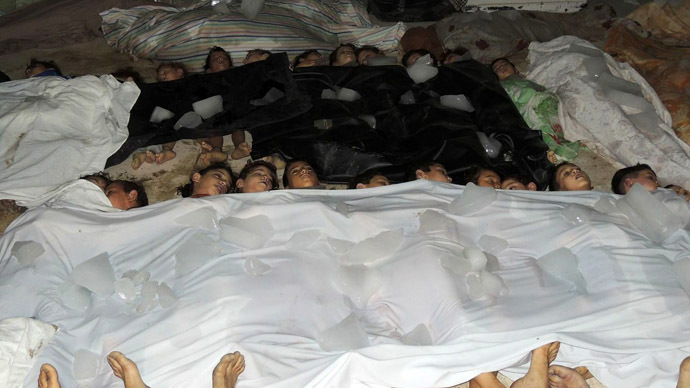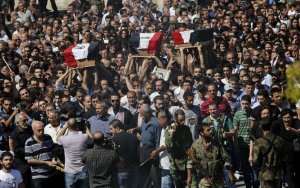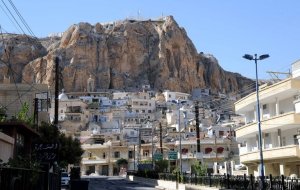One nun puts entire US intel community to shame over 'stage-managed' Syria footage
Published time: September 19, 2013 11:20
The US intelligence community has been put to shame by the dedication and determination of a lone Christian nun. Her modest study of the videos of the Syrian chemical attack shows they were productions involving staged bodies.
Those who take the time to read the report by Mother Agnesand the International Support Team for Mussalaha in Syria (ISTEAMS) will realize that it disgraces the entire US intelligence community for endorsing video footage that is clearly dubious and not credible upon careful study by even a layperson.
No one denies that chemical weapons were used. The US federal government and the mainstream media in the US and countries allied to it have been playing a dirty game of equating the a) rejection of accusations that the Syrian government used chemical weapons with b) an outright denial that chemical weapons were used. The two are deliberately being mixed together to confuse the general public. The question is who used the chemical weapons?
What is the US intelligence community?
Before I go any further, it has to be emphasized that the US intelligence community is a monstrous apparatus or network that has immense technological resources, mammoth amounts of funding, and massive manpower. It is a collective of all the intelligence bodies of the US government, which is formed by 16 different intelligence agencies.
Out of the agencies that form the US Intelligence community, one belongs to the US Treasury, one belongs to the US Department of State, two belong to Homeland Security, two belong to the US Department of Justice, one belongs to the US Department of Energy, eight belong to the Pentagon, and finally one of them is the Central Intelligence Agency (CIA), which is independent from any US government department.
The Pentagon's intelligence agencies are the Air Force ISR Agency (AFISRA), Army Intelligence and Security Command (INSCOM), Defense Intelligence Agency (DIA), National Reconnaissance Office (NRO), Marine Corps IA (MCIA), National Security Agency (NSA), National Geospatial Intelligence Agency (NGA), Office of Naval Intelligence (ONI).Aside from the non-departmental CIA, the rest of the departmental agencies are the Intelligence Division of the Drug Enforcement Administration, the Intelligence Division of the Federal Bureau of Investigation (FBI), Coast Guard Intelligence (CGI), the Office of Intelligence and Counterintelligence (OICI), the Office of Intelligence and Analysis (I&A), the US State Department’s Bureau of Intelligence and Research (INR), and the US Treasury’s Office of Terrorism and Financial Intelligence (TFI).
Nonetheless, this gargantuan body could not see what Mother Agnes Mariam has found and submitted to the United Nations. It is job of the agencies of the US intelligence community to examine these videos and to authenticate them. But they failed either to serve US foreign policy, or to show professionalism, or both.
Instead they nominated and endorsed a sample of footage from Syria as a means of proving that (1) the chemical weapons were used in the Damascus suburb of East Ghouta and (2) that the Syrian government was responsible for the diabolical attacks.
Dubious nature of videos selected by US intel community
The US intelligence community selected or nominated 13 videos that the Obama Administration used in their case against the Syrian government. These videos need to be carefully looked at.
The emphasis that US Secretary of State John Kerry put on the videos in his scripted speech that he read out to reporters on August 30, 2013, came across as ingenious. Kerry notably refers to the footage from Syria and constantly uses the words “our own eyes” and “seeing.” He even asks that the videos be watched by the general public. He should have been taken to task on this, and he was through the study that Mother Agnes has produced.
Undoubtedly there will be those who will dismiss the fact that there is an almost total absence of adult corpses next to the bodies of the children, nor any parents, especially mothers, coming to claim their children. Where were the parents? From a cultural context, this is strikingly odd. It is highly unlikely that the parents, especially the mothers of all these children, would have left them alone or not rushed to where their bodies were.
In one video where it is stated that all the bodies are dead, we can see that the some of the corpses are being injected with an unknown liquid. Why?
The report also highlights the fact that there have been no public funerals or announcements about all the dead children. This is outside of both cultural and religious norms.
In the footage of one burial, only eight people are buried and three of them are not even covered in white shrouds, which is a compulsory ritual. Were these people murdered by the insurgents and disrespectfully buried without the proper rituals as a sign of disdain?
Moreover, the identities of the dead have consistently been withheld. There is more to say on this and it should be kept in mind.
Mother Agnes also makes a point of indicating that there is virtually an absence of the sound of ambulances and that in the testimonies that are used the individuals talking claim to have smelled the chemical that was used. Sarin gas, however, is odorless, which raises important questions about the testimonies.
Stage-managed scenes
Even if one ignores some of the arguments in the Mother Agnes report, there are some observations in the study that are undeniable. These observations will lead anyone to conclude that the scenes in the footage that the US intelligence community nominated are stage-managed.
Some of the same bodies were planted or recycled in different scenes and makeshift morgues that were supposed to be in different locations. The same bodies of the same children are spotted in different locations.
There is additional footage that either gives a contradictory impression to that of the videos nominated by the US intelligence community for the Obama Administration or shows that children were being arranged and moved around.
A horrible conclusion
Many bad things have happened in Syria, including the chemical attack in East Ghouta. Yet there many questions that have to be answered.
There was a massacre in Latakia on August 4, 2013 that went unreported. The mainstream media in the US and the countries allied to it failed to cover this or casually pass it over, obviously because it was inconvenient to change the agenda in Syria.
The study mentions that the relatives of children that were abducted by the US-supported insurgents have begun to come forward to identify their relatives in the videos. It paints an ominous picture that the bodies of these children were prostituted to open the field in Syria for a foreign military intervention.
Regardless of whatever position one takes on Syria, it is their responsibility to analyze the videos from the alleged chemical attack and pay attention to observations of Mother Agnes Mariam’s report.
The statements, views and opinions expressed in this column are solely those of the author and do not necessarily represent those of RT.
























